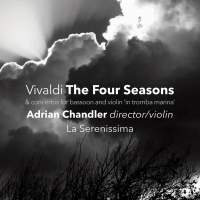Texte paru dans: / Appeared in: |
|
|
Outil de traduction ~ (Très approximatif) |
|
|
Reviewer: Robert
Maxham In his booklet notes, violinist Adrian Chandler provides a sketch of his modus operandi, both in general and in particular. He and La Serenissima, for example, eschew a metronomic approach to fast movements, experimenting with dynamics and tempos to realize pictorial details. And, again for example, they have given some thought to the dogs’ traditional association with melancholy, therefore allowing Vivaldi’s dog to cry out rather than bark in the Summer concerto. The tableau opens with the tutti fresh and crisp in Spring. Chandler’s wanders in tempo between storm and calm as the movement proceeds, recalling the genial flexibility of Claudio Scimone and I Solisti Veneti, although transmitted in this case with higher-voltage virtuosity. The concerto’s slow movement not only features canine interjections (not extraordinarily different in manner from what many listeners might expect) but leisurely improvisatory glosses by the violinist. In the finale, the ensemble strikes off flinty textural sparks, while Chandler’s solo features occasional metric liberties. Summer, in Chandler’s version, allows listeners to descry almost effortlessly details in the orchestral part that often appear submerged acoustically, and subordinated to the brilliant solo in importance; throughout he makes the birds sing with winning brightness and clarity. The slow movement sounds improvisatory and meditative, yet menacing, although he’s muted the minatory thunder rolls. Including legatos in the opening dance of Autumn (in both the tutti and solo parts) changes their character; and if this at first might seem novelty for novelty’s sake, it fits seamlessly into the improvisatory touches he incorporates as the movement proceeds. (Some of them—for example, the slow tempo of one of the ritornello’s returns and the long pause before the slower section—border on the extreme). Chandler and the orchestra make similar alterations to bowings in the finale, enhancing the horn calls with legatos that, whatever their effect, hardly diminish the hunt’s vigor. The orchestra brings a chill to the onset of Winter without relying on pinched effects at the bridge as others have, perhaps in imitation of the signal early recording by the Academy of St. Martin in the Fields. Chandler compounds aural quicksilver in the finale. The recorded sound seems spacious yet vivid. Avie fills out what might have been a bracing though short program with four further Vivaldi concertos, two for bassoon and two for violin in tromba marina. The first bassoon concerto brings movements, after the slow introduction, almost as pictorial as those in the Seasons: “Fantasmi,” “Il Sonno,” and “L’Aurora.” And, while these descriptions may not be gratuitous, bassoonist Peter Whelan and the ensemble provide a wealth of effects to occupy a listener’s attention quite beyond the graphic ones. Chandler ingeniously integrates the bassoon into the tuttis, but its emergence in the solos should nevertheless electrify many listeners. Chandler consulted violin maker David Rattray in converting a violin made in 1755 by Johann Andreas Doerffel to a violin in tromba marina (he used metal strings in doing so—wrapped strings seem to have been available at the time); and Chandler himself plays it in the first of the concertos for the instrument. Its distinctive timbres show themselves to particular advantage in the slow movement. The second bassoon concerto again sounds virtuosic and cracklingly articulated in the solo part of its opening movement, ardently lyrical in the slow one, and frothy in the finale. The program ends with a second concerto for violin in tromba marina, the first movement of which features the instrument’s buzzing double stops. Those
who fondly recall the rhythmic freedom and warm smile of I Solisti Veneti’s
version of the Seasons in particular and Vivaldi’s works in general will
welcome this avatar. But be warned, this kind of exploration might awaken
the ire of those who still detest period instrument performances as some
sort of imposture. Warmly recommended to those free from such biases. | |
|
|
|
|
Cliquez l'un ou l'autre
bouton pour découvrir bien d'autres critiques de CD |
|




